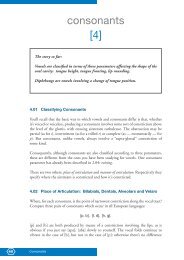PHONETICS MANUAL.indd - HumBox
PHONETICS MANUAL.indd - HumBox
PHONETICS MANUAL.indd - HumBox
You also want an ePaper? Increase the reach of your titles
YUMPU automatically turns print PDFs into web optimized ePapers that Google loves.
There’s a slight but significant difference between [t, d] in English as compared<br />
with the corresponding consonants in French, Spanish and Italian. In the last three<br />
languages the tongue is always placed against the back of the upper front teeth for [t,<br />
d], not against the teethridge, and this results in a slightly “sharper” sound. The term<br />
DENTAL is used in this case. (German [t] and [d] are alveolar, just as in English.)<br />
Fig. 27 shows the difference between the places of articulation for dental and alveolar<br />
consonants.<br />
Fig 27<br />
Dental [t, 9 d] 9<br />
Alveolar [t, d]<br />
As you can see from Fig. 27, the IPA specifies the dental/alveolar difference by placing<br />
a “tooth mark” below the dentals: [t 9 d].This 9 is obviously useful when languages are<br />
being compared. However, in everyday transcription of French, Spanish or Italian,<br />
the mark can be omitted: [t, d] are always dental in these languages, so it’s unnecessary<br />
to specify the fact every time one of them comes up.<br />
Though not exactly one of the most crucial pronunciation differences between<br />
English or German on the one hand and French, Spanish or Italian on the other, the<br />
[t d]/[t 9 d] 9 distinction isn’t difficult to achieve, and it’s worth the effort to make your<br />
pronunciation that little bit more authentic. Just remember to place your tongue<br />
fractionally further forward when you make the consonant.<br />
There’s no difference in place of articulation between English and the other languages<br />
in the case of [p, b] or [k, g].<br />
Now we can start building up the IPA consonant chart. Here are the four places of<br />
articulation mentioned so far. As with the vowel chart, the left-hand side corresponds<br />
to the front of the mouth, the right-hand side to the back.<br />
FIG. 28<br />
bilabial dental alveolar velar<br />
42 Consonants






